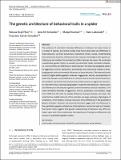Por favor, use este identificador para citar o enlazar a este item:
http://hdl.handle.net/10261/236805COMPARTIR / EXPORTAR:
 SHARE SHARE
 CORE
BASE CORE
BASE
|
|
| Visualizar otros formatos: MARC | Dublin Core | RDF | ORE | MODS | METS | DIDL | DATACITE | |

| Título: | The genetic architecture of behavioral traits in a spider |
Autor: | Kralj-Fišer, Simona; Schneider, Jutta M.; Kuntner, Matjaž; Laskowski Kate; García-González, Francisco CSIC ORCID CVN | Palabras clave: | Animal models Animal personality Heritability Sexual dimorphism Sexual selection |
Fecha de publicación: | 2021 | Editor: | Wiley-Blackwell | Citación: | Ecology and Evolution, 1-12 (2021) | Resumen: | The existence of consistent individual differences in behavior has been shown in a number of species, and several studies have found observable sex differences in these behaviors, yet their evolutionary implications remain unclear. Understanding the evolutionary dynamics of behavioral traits requires knowledge of their genetic architectures and whether this architecture differs between the sexes. We conducted a quantitative genetic study in a sexually size-dimorphic spider, Larinioides sclopetarius, which exhibits sex differences in adult lifestyles. We observed pedigreed spiders for aggression, activity, exploration, and boldness and used animal models to disentangle genetic and environmental influences on these behaviors. We detected trends toward (i) higher additive genetic variances in aggression, activity, and exploration in males than females, and (ii) difference in variances due to common environment/maternal effects, permanent environment and residual variance in aggression and activity with the first two variances being higher in males for both behaviors. We found no sex differences in the amount of genetic and environmental variance in boldness. The mean heritability estimates of aggression, activity, exploration, and boldness range from 0.039 to 0.222 with no sizeable differences between females and males. We note that the credible intervals of the estimates are large, implying a high degree of uncertainty, which disallow a robust conclusion of sex differences in the quantitative genetic estimates. However, the observed estimates suggest that sex differences in the quantitative genetic architecture of the behaviors cannot be ruled out. Notably, the present study suggests that genetic underpinnings of behaviors may differ between sexes and it thus underscores the importance of taking sex differences into account in quantitative genetic studies | Versión del editor: | https://doi.org/10.1002/ece3.7430 | URI: | http://hdl.handle.net/10261/236805 | DOI: | 10.1002/ece3.7430 |
| Aparece en las colecciones: | (EBD) Artículos |
Ficheros en este ítem:
| Fichero | Descripción | Tamaño | Formato | |
|---|---|---|---|---|
| ece3.7430.pdf | 868,43 kB | Adobe PDF |  Visualizar/Abrir |
CORE Recommender
PubMed Central
Citations
3
checked on 06-may-2024
SCOPUSTM
Citations
3
checked on 03-may-2024
WEB OF SCIENCETM
Citations
3
checked on 24-feb-2024
Page view(s)
78
checked on 05-may-2024
Download(s)
89
checked on 05-may-2024

